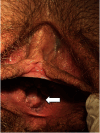Davydov Vaginoplasty in Mayer-Rokitansky-Küster-Hauser Syndrome Patient Presenting With Urethral Dilatation
- PMID: 38962289
- PMCID: PMC11221995
- DOI: 10.1155/2024/9498667
Davydov Vaginoplasty in Mayer-Rokitansky-Küster-Hauser Syndrome Patient Presenting With Urethral Dilatation
Abstract
Introduction: Mayer-Rokitansky-Küster-Hauser (MRKH) syndrome is a female congenital disorder characterized by an underdeveloped or absent vagina and uterus. The first-line treatment to create a neovagina is patient-performed vaginal dilatation. We report here the rare case of an MRKH patient who presented with urethral dilatation and was successfully treated with Davydov vaginoplasty. Case Report: Seventeen-year-old patient with known single kidney was consulted by a gynaecologist, and a diagnosis of MRKH syndrome was established. As the patient had urethral dilatation-resulting from repetitive intraurethral intercourse-neovaginal creation by means of self-performed vaginal dilatation was precluded. Rather, the Davydov vaginoplasty was successfully performed; there were no postoperative complications, and the patient was fully continent postsurgery. Conclusion: MRKH patients and healthcare providers should be educated on the damaging consequences of intraurethral intercourse. More cases need to be reported to establish the best treatment options for a normal sexual life.
Keywords: Davydov vaginoplasty; Mayer–Rokitansky–Küster–Hauser syndrome; urethral dilatation; urethral intercourse.
Copyright © 2024 Jurgis Vitols and Lasma Lidaka.
Conflict of interest statement
The authors declare no conflicts of interest.
Figures





References
-
- Cheikhelard A., Bidet M., Baptiste A., et al. Surgery is not superior to dilation for the management of vaginal agenesis in Mayer-Rokitansky-Küster-Hauser syndrome: a multicenter comparative observational study in 131 patients. American Journal of Obstetrics and Gynecology . 2018;219(3):281.e1–281.e9. doi: 10.1016/j.ajog.2018.07.015. - DOI - PubMed
-
- Martens L., Kluivers K. B. Urethral coitus due to congenital abnormality of the genitalia. Nederlands Tijdschrift voor Geneeskunde . 2020;164, article D4189 - PubMed
Publication types
LinkOut - more resources
Full Text Sources
Research Materials

